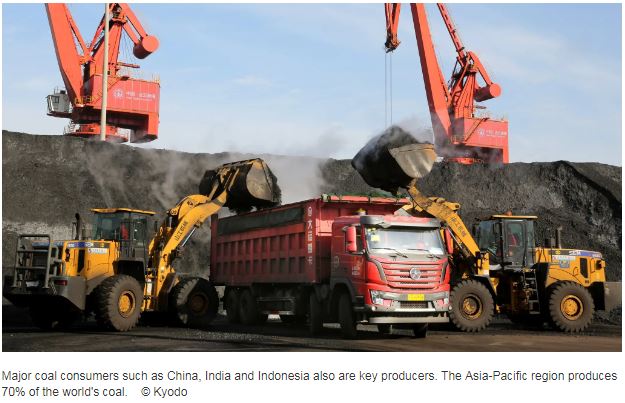Southeast Asian coal demand to grow at fastest rate in world
TOKYO — Southeast Asian coal demand is forecast to rise 5% yearly through 2023 for the fastest growth rate worldwide, an International Energy Agency report published Tuesday says, as Asia makes up for declines in usage elsewhere.
Global coal demand appears likely to grow in 2018, though the IEA report predicts this demand will remain stable over the next five years.
India, China and Indonesia play major roles both as consumers and producers of coal, the biggest global emitter of carbon dioxide — a greenhouse gas — among energy sources. The Asia-Pacific region produces 70% of the world’s coal, the IEA says.
Coal demand worldwide rose by 1% in 2017 after two years of decline, with decreases in Europe and the U.S. offset by growth in Asia.
Global economic growth drove increases in both industrial output and electricity use, with 61% of coal used to generate electricity while 19% went mostly for iron and steel production.
Global coal power generation increased by about 3%, accounting for 40% of the additional power generated worldwide. Developing countries with pressing demand for electricity often prefer coal, seeing it as the most abundant and cost-effective energy source.
India looks to account for the largest absolute rise in coal use, with the country responsible for 12% of global consumption in 2017. Its projected annual economic growth of 8% to 2023 will lift power demand by more than 5% yearly, the IEA says.
But India’s yearly growth in coal demand is expected to slip below 4% through 2023 from the annual average of 6% in the past decade, thanks to the national push for renewable energy and the installation of more efficient technology for coal power generation.
However, China accounts for almost half of global coal consumption, and “coal’s fate largely rests on the Chinese power sector,” the IEA report said. Consumption nationwide increased marginally by 0.3% in 2017 after three years of decline.
Shinichiro Takiguchi, senior specialist at the Japan Research Institute, said “it is difficult to stop building new coal-fired power plants because the market is growing.”
China’s goal of cutting carbon dioxide emission levels per unit of gross domestic product means that Beijing is balancing environmental policies with economic growth, Takigichi said.
Nevertheless, China’s coal demand is forecast to decline over time due to state-led policies pushing toward renewable energy and natural gas, the IEA says.
On Saturday at annual UN climate talks in Poland, nearly 200 countries reached an accord to implement the Paris Agreement from 2020. Countries are to submit revised plans for greenhouse gas reductions.
The shift to cleaner energy is proving difficult, even in developed countries. In France, the government suspended its planned fuel tax increases after they were met by street protests.
Global pressure to reduce coal and increase renewable energy has led international banks such as ING and BNP Paribas to set guidelines for reducing their exposure to coal projects.
HSBC said this year it would stop financing new coal plants except in Bangladesh, Indonesia and Vietnam. These exceptions were made “in order to appropriately balance local humanitarian needs with the need to transition to a low-carbon economy,” HSBC said.
In Japan, financial institutions including the three biggest banks have followed the global trend to limit funding for coal projects, although they have not ruled out financing them.
Mitsubishi UFJ Financial Group guidelines say the company will “carefully consider” the financing of coal-fired plants based on international guidelines.
“Corporate management based on ESG [environmental, social and governance concerns] is the current premise for business continuity and sustainable growth,” MUFG said.
Dai-ichi Life Holdings will not provide financing for coal power projects abroad, under a company rule, but the insurer does not rule out domestic projects.
“As a Japanese institutional investor, our view is that we need to take Japan’s energy policy into consideration,” Kazuyuki Shigemoto, general manager of the investment planning department, said in a statement. Dai-ichi currently finances no coal-fired power plant project.
Trading house Marubeni this year became the first Japanese non-financial company to promise a withdrawal from new coal projects. The company also aims to cut its coal-fired electricity volume in half by 2030, in order to shift capital and manpower to renewable energy.
“Financial and insurance sectors have tremendously decreased their investment in coal,” said Takashi Fujinaga, senior operating officer of Marubeni’s power division.
Yet the company might pursue future projects with the current best available technology, the ultra-supercritical steam generator. Marubeni also is continuing ongoing coal projects in countries such as Indonesia and Vietnam.
The impact of these initiatives on coal consumption is debatable. Divestment by financial institutions would affect the cost of coal power projects, but the world remains “quite early on in the process of pushing coal out,” said Simon Flowers, chief analyst and chairman for U.K. based research company Wood Mackenzie.
“We expect under any circumstances for fossil fuels to provide over 70% of all primary energy demand for the next 25 years,” Flowers said.
Source: https://asia.nikkei.com/Business/Markets/Commodities/Southeast-Asian-coal-demand-to-grow-at-fastest-rate-in-world


 English
English






